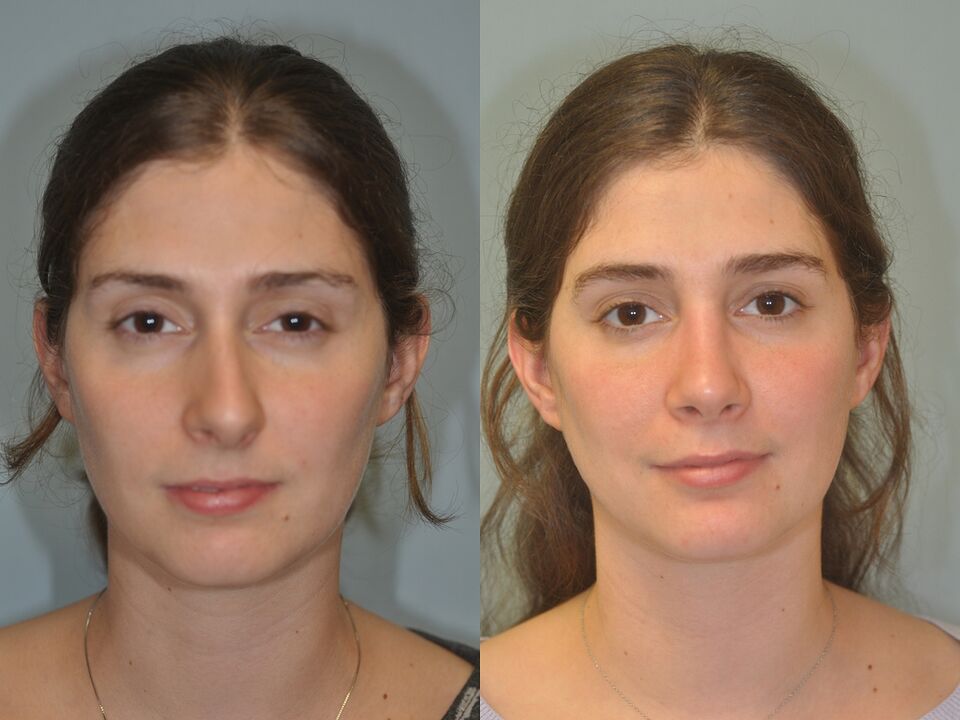
Rhinoplasty (formed from two other Greek words with the meaning of "nose" + "plastic", therefore, is literally translated as "plastic nose") is a section of plastic surgery, involved in congenital correction (obtained at the stage of embryogenesis) and nasal deformations acquired throughout life.Simply put, this is a plastic surgery to correct external and internal defects in the nose.Distinguish between open, closed and non -surgical rhinoplasty.In most cases, aesthetic and functional defects are surgically eliminated.
Initially, the correction was performed only in connection with injuries, serious diseases and noticeable congenital defects.Later, plastic surgery began to be done, most of the time, according to aesthetic indications, in order to change the appearance of the nose.For example, remove the hunchback, reduce the tip, lift the bridge from the nose, reduce the nostrils and so on. A small story. For the first time, surgeons in the ancient world performed rhinoplasty. It was mentioned in the old manuscript of "Ayurveda", dating from OK.1000 AC This document captures most facts about antiquity medicine.The restoration of face units was required by wars and people who were mutilated in the battle during the execution of the court sentence.At this point, the transplant began its story.As a correction material, the skin of the cheeks or skin on the forehead has been taken.Indian technology over time has developed so that, in the Middle Ages, even European doctors, dominating them, successfully operating in patients.
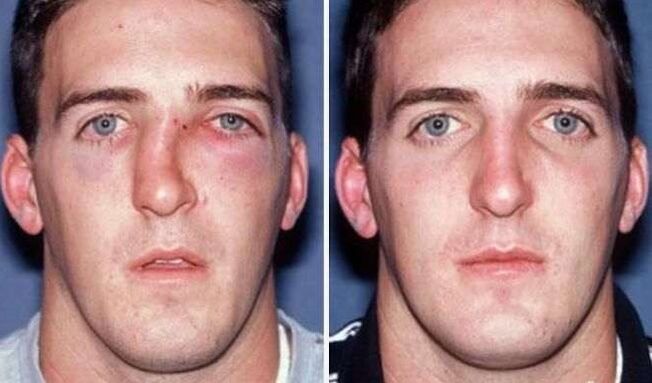
Indications for Rhinoplasty
Rhinoplasty is done according to medical and aesthetic indications.In other words, a people just don't like what the nose is like.It can be with a hunchback or curved, very large or small, wide or narrow, despised or long, with large or asymmetrical nostrils.And it turns out that a person's nose has been twisted from birth or due to a blow (although it can often not breathe and an operation is needed to restore nasal breathing).There are frequent cases where operation is necessary to correct appearance defects after the first unsuccessful plasticity (this is considered the most difficult surgical intervention).The operation is allowed only to people over 18 (if there are no urgent medical indications).This is due to the fact that bone tissue is formed until eighteen and the cartilage reaches twenty.This is why the most suitable age for rhinoplasty of 20 to 35 years.The following is a description of the most common problems with which men and women resort to rhino surgeons.
Nose with a hunchback
The essence of the problem: There is a small hunchback on the back of the nose, because the nose seems more huge, and the face is moodless and dissatisfied.Reason: The defect may be congenital, may appear after an injury or may be the previously unsuccessful correction result.The removal method: In most cases, in plastic surgery, the hunchback is removed by a closed or open method under general anesthesia.If the back of the nose is very wide, it is necessary to do rhinoplasty with osteotomy (approach of rear bones)
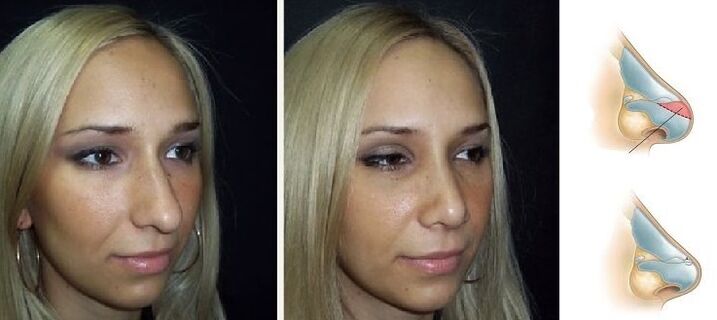
A back of the nose
The essence of the problem: A person has a very wide nose, which makes the face huge and rude.Reasons: A defect may appear after an injury, be congenital, or become the result of unsuccessful removal of a hunchback.Resolution Method: Open correction with osteotomy under general anesthesia.The essence of this technique is that part of the bone on the back is removed and then the side parts are gathered.
The Nose of Nosy Pie
The essence of the problem: The back of the nose is asymmetrical.Due to curvature, a person often cannot breathe.This problem refers to functional indications for surgical correction.As a defect appears: In most cases, this is the result of a fracture.Although it happens that the nasal partition is curved as a result of the intensive growth of skull bones during growth.Is it possible to straighten the nose? In most cases, an operation to match the partition (septoplasty) is undergoing a closed method under local anesthesia.The essence of the operation is shown in the diagram below.If this is not enough, in these cases, they resort to rinosptoplasty (when partition correction is combined with the elimination of other nose -shaped defects).In cases where the lesion is quite serious, they resort to reconstructive plastic (more severe surgical intervention, which is usually performed at various stages), this section of plastic surgery studies methods of nose restoration after serious injuries and in cases of complete absence.The surgeon's task in this case is the restoration of the integrity of the base of the cherry and the skin.
The shape of the saddle of the nose
The essence of the problem: the nose is very low.Because of what, the shape of the nose resembles a profile saddle.Reason: The defect may be congenital, may appear as a result of an injury when part of the bone or cartilage has been damaged.How can you change the situation? The correct shape is restored by transplanting a costal cartilage, auricle cartilage (outside the ear) or implanting a synthetic implant.
Nose

The essence of the problem. The very large (long or wide) nose makes the face disproportionate.Most of the time, in these cases, the tip is very thickened.Reason: The defect is more often congenital. How do they solve the problem? The nature of surgical intervention depends on the cause (in some cases, it is necessary to reduce the tip tip, in others the wings of the nose are reduced, but it happens that it is necessary to remove the hunchback).Before deciding that it is possible to make plastic surgeons resort to 3D computer modeling.This allows you to see even before the operation as the face will be after the procedure.
The shape of the problem of the tip of the nose
The essence of the problem: Correct face proportions are violated due to the wrong form of the nasal tip.For example, it can be:
- Narrow
- Wide
- Round (nose with potatoes or bulbs)
- Back (crochet)
- Raised (Kurting)
- Forked
How do they solve the problem? The course of the operation is thought, depending on the type of problem.
- To reduce the wide tip, it is sufficient to tie the large cartilage dome and, in others, it is additionally necessary to truncate part of the cartilage fabric.
- A more often a round fleshy tip needs to remove part of the cartilage, followed by approaching the domes, also usually reduces the wings during operation.
- The bifurcated tip of the nose needs to install a transplant from the patient's cartilage tissue collected in the EAR or rib area, or the synthetic material.
- The tip may seem very narrow due to disorders associated with the loss of the rigidity of the side legs of the cartilage.They are strengthened, also using transplants.
- During the lengthened tip correction of the nose, the surgeon removes part of the cartilage and raises it sewing, fixing it in a new position.
- Another operation of the operation implies the strengthening of Columella from the nose to ensure good end support.
- There is a third method associated with the truncation of part of the inner muscle, after which the tip is pulled up
- Kournostability is also eliminated in many ways involving the installation of their own transplants or synthetic at the tip of the tip or nose bridge.
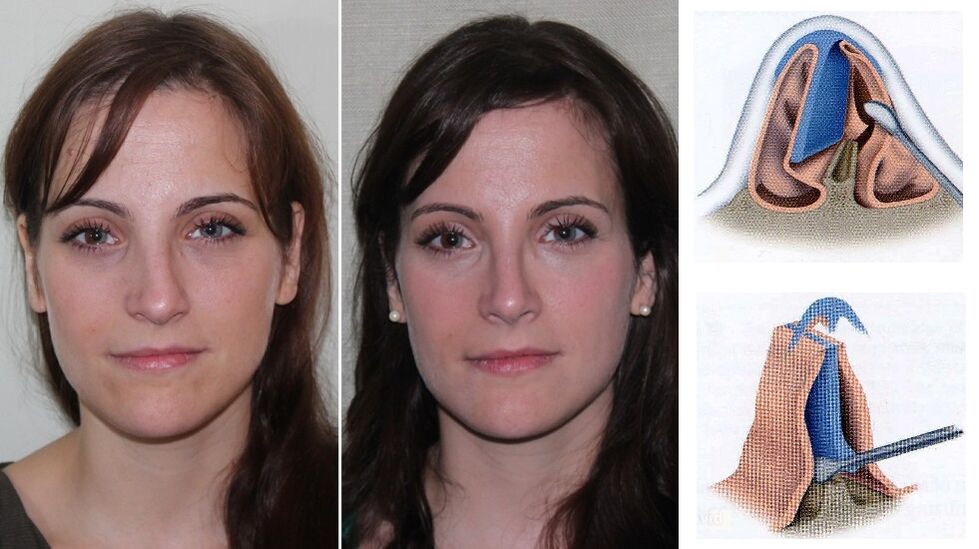
Large or different nostrils
The essence of the problem: The disproportionate size of the nostrils (too small or large) or significant asymmetry can disrupt harmony and worsen the appearance of the face.How to eliminate the defect? The course of the operation depends on the source of the problem.They can sew the wings of the nose, it may be necessary to strengthen the retirement cartilage domes and, in some cases, is sufficient to align the nasal septum.It turns out that it is necessary to increase or reduce the long tip of the nose
Against -indications to rhinoplasty
Against the absolute indications in which rhinoplasty should not be done in any case:
- Diabetes I, Type II
- Coronary heart disease and other diseases cardiovascular diseases in which general anesthesia is against it
- Meningitis, tuberculosis, gonorrhea, brucellosis and other serious viral infectious diseases
- System Diseases: Red lupus, HIV, leprosy and others.
- An allergic reaction to the components of anesthesia.
- Chronic diseases: hepatic cirrhosis, hepatitis, etc.
- Cancer
- Bronchial asthma
- Blood coagulation problems
- Mental illness
Against relative -indications (rhinoplasty can be done if the disease is cured) to relate:
- Age up to 18 years (correction is acceptable only in the most extreme cases)
- Exacerbation of inflammatory diseases (sore throat, front, sinusitis, otitis media)
- ARS, Sars
- Skin diseases
- Age after 50 years (surgery is performed if there are no chronic diseases related to against Absolute -Indications)
- Pregnancy, lactation, menstruation
How rhinoplasty passes
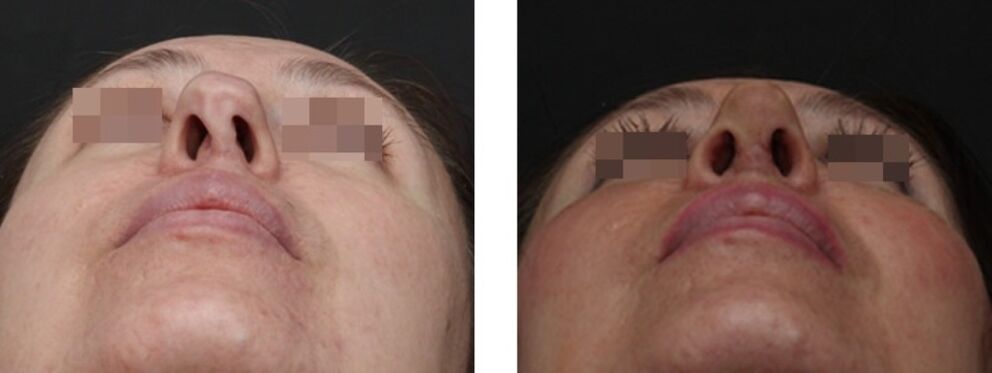
Rhinoplasty is done only under general anesthesia.The duration of the procedure depends on the complexity of surgical intervention and ranges from 30 minutes to 2 hours.During the first appointment, the doctor offers to make 3D modeling to get a complete understanding with the patient.This helps to show a person what end result can be expected.When he imagines that in the end it is easier for him to make a conscious choice.Prior to operation, the patient needs to undergo a general and biochemical blood test and a general urine test.You will also need to have a blood test for HIV and a blood test analysis for Protrombin.It will be necessary to do an electrocardiogram and take an inspection with profile doctors if necessary.Patient preparation in the preoperative period includes the following recommendations:
Two weeks before the operation:
- Refuses to drink alcohol (especially carbonated)
- Do not take blood tuning drugs
- Don't take a sunbathing
- Smoking Prohibited
One week before the procedure:
- Acquire all the necessary medicines
- Minimize the use of cosmetics
- Buy contact lenses to replace glasses (for people with bad vision)
10 hours before operation:
- Do not drink anything (or drink the minimum amount of liquid)
- Do not use perfume and cosmetics
- Prepare clothes that do not need to be removed on your head
- Remove jewelry
Rehabilitation after rhinoplasty
Full restoration of tissues after rhinoplasty occurs a year after surgery.To accelerate the tissue healing process and prevent undesirable consequences, it is extremely important to strictly observe the doctor's recommendations on the post -operative period.In the early days after the operation, the patient is discomfort due to the fact that he has to constantly use plaster and support tampons on his nose.This means that you can only breathe with your nose, your mouth usually dry.The temperature can be increased.I want to drink.It is difficult to wash and brush your teeth.Remove the plaster and remove tourists from the nose earlier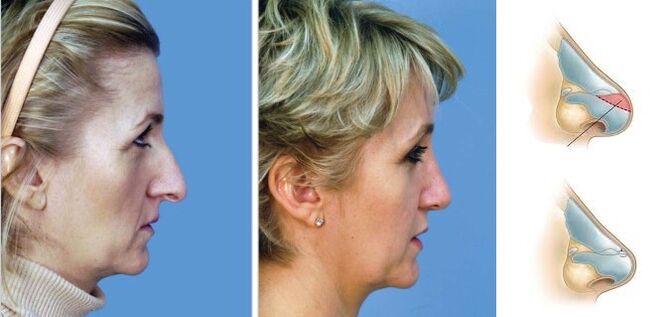 It is impossible for.This can lead to undesirable deformations, an increase in swelling and problems with tissue healing.
It is impossible for.This can lead to undesirable deformations, an increase in swelling and problems with tissue healing.
The first five five days of Edema will intensify and then begin to decrease.To restrict swelling, it is recommended to make cold compresses on the first day.After removing plaster sauce for about two weeks, people will continue to suffer discomfort caused by nose edema.Perhaps some loss of sensitivity in the field of surgical intervention.Hematomas are still visible.Right now, breathing with the nose is easier. During rehabilitation, in the first week, surgeon rhinoplasts recommend adherence to the following restrictions:
- You cannot eat very salty, spicy, acidic and others, simple and digested foods.
- You cannot tilt your head down, take a shower, lift weights (including bringing a child or pet with 5 kg more.) And carry.
- You will have to sleep only on your back on a high pillow.
A person may work two weeks after surgery, although it is necessary to avoid heavy physical work.Therefore, it is best to plan vacation for this time to provide full rest and complete rest for rapid recovery.
Within two months after rhinoplasty:
- It is necessary to rinse the nasal cavity regularly
- You cannot undergo serious physical effort, play sports or go to the pool
- You can't drink alcohol
- You can't smoke
- Reduce or eliminate the use of coffee
- It is forbidden to visit a bathroom or sauna
- It is necessary to avoid direct sunlight on the face
- You cannot wear glasses.They affect the shape of the nose bridges, so you need to wait until the bone is completely heal.
Possible complications after rhinoplasty
It is considered a normal state if immediately after surgery, there are bruises around the eyes and swelling.They are a direct consequence of damage during small vessel surgery.After almost two weeks, edema and primary bruises should already fall.
The first complications include the following problems:
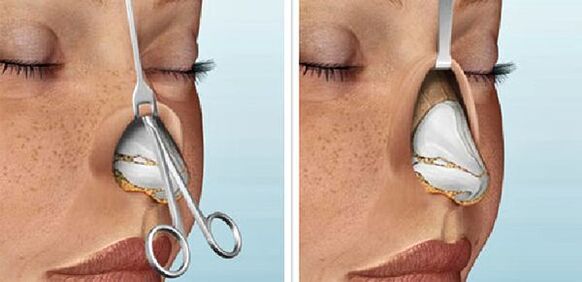
- Bleeding
- Hematoma
- Very strong edema
- Fabric necrosis
- Wound infection
- Sewing
- Nose
If these problems appear, it is necessary to resort to your assistant surgeon in a timely manner and start treatment over time and prevent its additional development.
Late complications include:
- Perhaps the appearance of bones
- The formation of keloid scars
- Opinion of the tip of the nose
- The fork of the tip of the nose
- The shape of the saddle of the nose
- The curvature of the back of the nose
- Asymmetry
- The appearance of a hunchback on the nose
- Partition drilling
- Hard to breathe
Most complications listed above can be eliminated using repeated operation.Some of them appear due to the surgeon's errors, others due to the patient's improper behavior failure during the recovery period, and the occurrence of some is explained by the various characteristics of the human body.




















